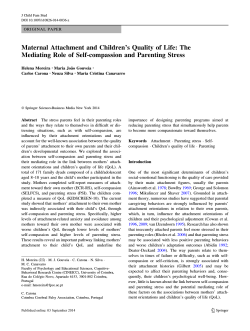
connections programme for young people
Barnardo’s Connections programme for young parents 2015 Crime Survey for England and Wales • Among both men and women, the prevalence of intimate violence was higher for younger age groups. Women aged between 16 and 19 and between 20 and 24 were most likely to be victims of any domestic abuse Young parents • Pressure in abusive teenage relationships not to use birth control– birth control sabotage is partly responsible for the fact that girls in abusive relationships are six times more likely to become pregnant in their teens (Rosen 2004). • NHS estimates that 30% of domestic abuse cases commence during pregnancy (NHS 2011) • 70% teenage mothers experience IPV (Rosen 2004). 2013 - local needs identification for Renfrewshire D.A. incidents reported to Police D.A.U. up by 11% from 201112 mainly due to a rise in cases involving teenagers and younger adults Housing and homeless prevention – number of homeless presentations for under 21 years old experiencing D.A. = 30% of overall figures – and believed to be under-reported. Structured work vs non-directive work There has been a huge amount of offender-oriented intervention research on youths and adults in recent decades. Lösel (2001) summarises this research by saying that: “…nearly all research syntheses showed relatively consistent differences between modes of treatment: theoretically and empirically driven wellfounded, multimodal, cognitive-behavioral and skill-oriented programs that address the offenders’ risk, needs, and responsivity had substantially larger effects than the overall mean”. He goes on to say that, “in contrast, traditional psychodynamic and non-directive therapy and counselling, lowstructured milieu therapy and therapeutic communities, merely formal variations in punishment, had relatively weak or no effects.” (Lösel 2001:68) De Vries et al. 2015 Meta-analysis of 39 studies of around 1000 young people at risk of ‘persistnant juvenille delinquency’ taking part in prevention programmes • Multimodal programmes were most effective • Group based interventions with young people had no good overall impact – even has small negative impacts • Individual work with the yp alone was worthwhile • Lower frequency – once per week preferred – and briefer interventions for lower risk youths Connections programme Mums’ and Dads’ programmes 18 sessions 1-1 1 hour session is divided into around 30 mins structured work and 30 mins practical advocacy style support Clear interagency protocols Draft ready to pilot April/May 2015 Can be combined with: VIG to foster sensitive parenting Healthy relationships sessions Intensive one to one: RIC/safety planning etc Prenatal and new baby group Parenting groupwork based around Five to Thrive approach Young Dads’ programme 8 7 6 5 4 3 2 Series1 1 0 Getting to know you, transition to parenthod, assessing risk, support infant development and and safety planning, close the impacts on children of parental conflict, child contact understanding the range of IPV including jealousy and peer pressure, CBT and anger management and conflict resolution Time line • What did you think about being a parent back before you were aware of the pregnancy? • How did you feel when you first found out about the pregnancy? • How did your expectations compare to the reality? • How do you think other people see you as a parent? Kim – Domestic abuse Young child Young parents Jealousy Peer pressure Contact issues Latimer creative media Peer pressure – own situation • Do you get annoyed about things that happen between you and your partner in public? If so what – give me an example? • At worst what do you imagine people say and think about you and her? • Have you ever got caught up in arguments because you heard about something someone said about you? • Do you think that when you’re 40 you’ll be as bothered about these things? If not, why and how will you have changed? Can you achieve a bit of that right now? Own parents • Share 3 parenting behaviours you appreciated and would like to do the same as one or both of your parents/ carers did. • Share 3 parenting behaviours you did not like and would like to do differently from one or both of your parents/ carers. 16
© Copyright 2025

















